Images Confirm That Newly Unveiled YJ-15 Is An Air-Launched Supersonic Anti-Ship Cruise Missile
🇨🇳
Note: The following text was originally posted on my X/Twitter account.
The ramjet-powered YJ-15 supersonic anti-ship cruise missile mockups that were displayed at the recent military parade in Beijing feature suspension lugs, which is to say that these were meant to represent air-launched anti-ship cruise missiles. The YJ-15 is likely to be integrated with the PLA Navy Air Force's (PLANAF) carrier-borne catapult-assisted take-off barrier arrested recovery (CATOBAR) J-15T fighter aircraft, the PLA Air Force's J-16 fighter aircraft, and perhaps the PLAAF's H-6K/H-6J/H-6N bomber aircraft.
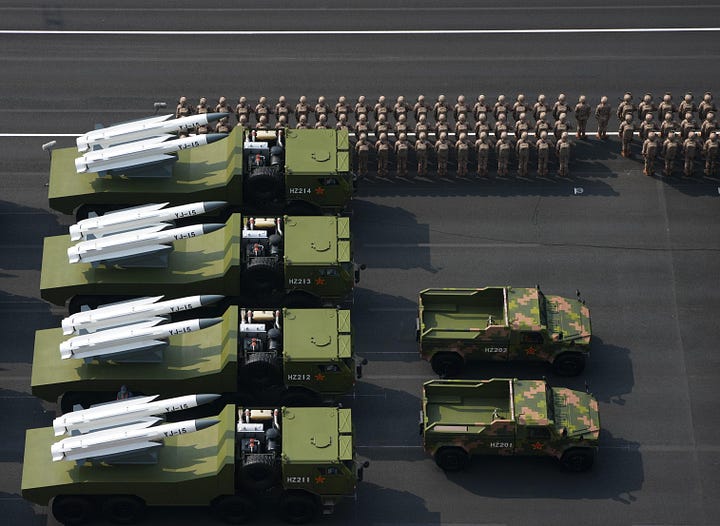
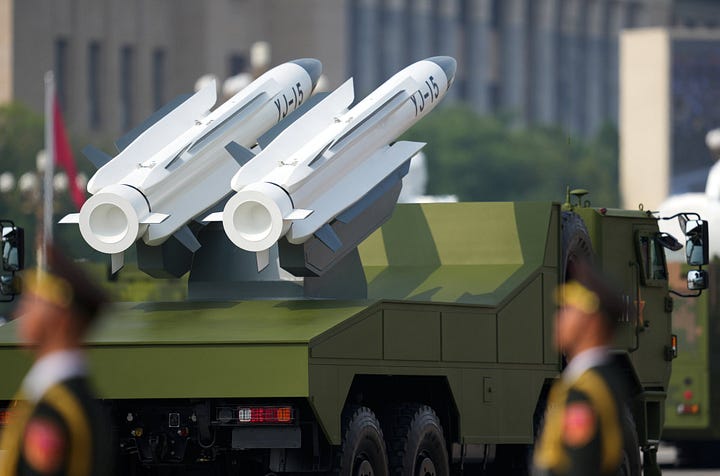
The PLAAF, which currently holds a near monopoly over air-launched anti-ship munitions in the People's Liberation Army (PLA), received the bulk of the PLANAF's land-based fixed-wing crewed combat aircraft in 2023. This includes the PLANAF's H-6G/H-6L and H-6J bombers, which were optimized for maritime strike, unlike the PLAAF's H-6 bomber variants, which were until ca. 2020 primarily used to employ stand-off land-attack munitions. While all of the PLAAF's H-6K, (ex-PLANAF) H-6J—and seemingly the closely related and reportedly nuclear-armed H-6N—bombers as well as the older (ex-PLANAF) H-6G/H-6L are capable of launching the preceding ramjet-powered YJ-12 supersonic anti-ship cruise missile, which was unveiled at the 2015 iteration of the recent military parade, all of the aforementioned versions of the H-6 bomber design other than the older (ex-PLANAF) H-6G/H-6L appear to be limited to carrying no more than 4x YJ-12 air-launched anti-ship cruise missiles per sortie. This is despite each of these aircraft having a total of six wing-mounted weapons stations that can be used to carry and launch the likes of the long-range KD-20 (subsonic) air-launched land-attack cruise missile.
The new YJ-15 appears to be considerably smaller and lighter than the preceding YJ-12. Should it be integrated onto the PLAAF's H-6K/H-6J/H-6N bombers—likely alongside the PLAAF's J-16 fighters (and perhaps other aircraft) and the PLANAF's carrier-borne CATOBAR J-15T fighters—the deployment of the YJ-15 will likely substantially enhance the maritime strike capabilities of the PLAAF's sizeable bomber force.
Something to keep in mind with respect to the possibility of integrating the newly unveiled ramjet-powered YJ-15 supersonic anti-ship cruise missile on the PLA Air Force's (PLAAF) Shenyang J-16 fighters and PLA Navy Air Force's carrier-borne Shenyang J-15T fighters is the mass of the YJ-15, which is not public knowledge. The closely related Chinese-built J-16 and J-15T are two of the Chinese derivatives of the Soviet Sukhoi Su-27 fighter aircraft (NATO: Su-27 Flanker), and for the most part share the structural limitations of the underlying Soviet twin-engine heavy fighter aircraft design.
The PLAAF's J-16 and the PLANAF's carrier-borne catapult-assisted take-off barrier arrested recovery (CATOBAR) J-15T are likely to be limited to carrying payloads of up to 1500 kg on three weapons stations (2x yellow and 1x red in image 1), up to ~600 kg class payloads on 6x weapons stations (blue in image 1). While the specific payload restrictions for the J-16 and J-15T are not public knowledge, the centerline station (red in image 1) of these fighter aircraft may be rated for 2000-3000 kg-class payloads. The heaviest publicly documented strike munition carried by the J-16 is likely to be the KF-98 air-launched cruise missile (image 2). As with all Su-27 family fighter aircraft other than the heavily modified Su-34 strike fighter, the J-16 and J-15T are not configured to carry drop tanks/external fuel tanks, which would ordinarily be the largest and heaviest external payload carried on a fighter aircraft.

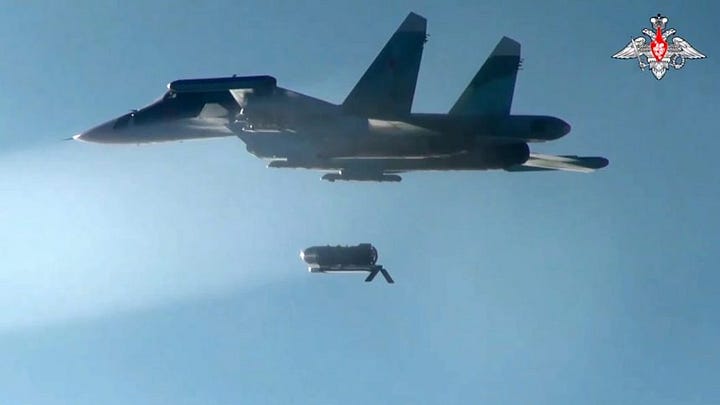
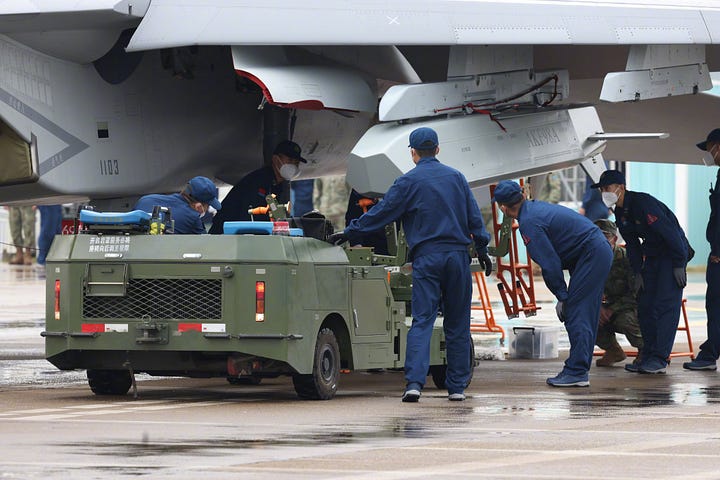

The largest and heaviest publicly known payloads carried by Su-27 family aircraft are the FAB-3000 aerial bomb (image 3), which can be carried by the Su-34 strike fighters operated by the Russian Air Force, and the ramjet-powered BrahMos-A supersonic anti-ship cruise missile (image 4), which is carried by the Indian Air Force's Su-30MKI fighters. The FAB-3000 is a 3000-kilogram class bomb, while the BrahMos-A, which is a lighter and more compact version of the BrahMos, is reportedly a 2200-kilogram class cruise missile. It bears emphasis that the Su-34 is a heavily modified strike fighter derivative of the underlying Su-27 fighter design and that there are other considerations at play, including volume and the aerodynamic effects of carrying a given munition on a given weapons station, irrespective of its mass.
Given the above, a given PLAAF J-16 and/or PLANAF CATOBAR J-15T can only carry a limited number—either one, two, or three—of large strike munitions. While it remains to be seen how many YJ-15 supersonic anti-ship cruise missiles these Chinese combat aircraft can carry, it bears emphasis that the ability to carry even one YJ-15 amounts to a major enhancement of the maritime strike capabilities of these Chinese fighter aircraft designs. The preceding ramjet-powered YJ-12 supersonic anti-ship cruise missile is far too large and heavy to be carried by either the J-16 or the J-15T—the air-launched version of the YJ-12 is exclusively carried by the PLAAF's H-6K, H-6J, (presumably) H-6N, and older H-6G/H-6L bomber aircraft. As a result, the J-16 and J-15T are limited to using the rather rudimentary subsonic YJ-83K and, supposing that it is deployed by the PLAAF and/or PLANAF, the supersonic YJ-91A, which is the anti-ship version of the YJ-91 passive anti-radiation missile and the Chinese version of the Soviet-Russian Kh-31 family of supersonic anti-radiation/anti-ship cruise missiles. While it is a supersonic anti-ship cruise missile, the YJ-91A and even the most recent extended-range version of the underlying Soviet-Russian design, the Russian Kh-31AD, offer an inadequate nominal maximum range given the fast-evolving threat environment. The new ramjet-powered YJ-15 supersonic anti-ship cruise missile is likely to offer Chinese combat aircraft a formidable standoff maritime strike capability.
These images of the carrier-borne catapult-assisted take-off barrier arrested recovery (CATOBAR) J-15DT (images 1-2), which is a fighter aircraft configured to primarily perform an electronic warfare role, indicate what the PLA Navy Air Force (PLANAF) considers to be adequate ground clearance for external stores. While the stores in question are electronic warfare pods, the same payload/weapons stations can be used to carry munitions on the CATOBAR J-15T fighters—from which the J-15DT is derived—that will operate from the Fujian, China's first CATOBAR aircraft carrier—currently undertaking sea trials—and future Chinese CATOBAR aircraft carriers more generally.
The original short take-off, barrier-arrested recovery (STOBAR) J-15 fighters, which operate from China's two operational STOBAR aircraft carriers, the Liaoning and Shandong, are severely limited in terms of maximum payload when taking off from said STOBAR aircraft carriers. As a result, observers have had little opportunity to discern the loadout options of the CATOBAR J-15T on the basis of the STOBAR J-15. Future imagery and video of the J-15T operating from the CATOBAR aircraft carrier Fujian will allow observers to discern how the CATOBAR J-15T can be armed and, as such, the missions that China's CATOBAR carrier air wings will undertake. With the STOBAR Liaoning and Shandong and associated STOBAR J-15 fighters, PLANAF (STOBAR) carrier air wings were primarily limited to air-to-air missions by default. With CATOBAR J-15T fighters (and J-15DT electronic warfare versions thereof) operating from CATOBAR aircraft carriers like the Fujian, PLANAF (CATOBAR) carrier air wings will have essentially as much flexibility in armament options as the CATOBAR J-15T does when operating from a terrestrial runway and the PLA Air Force's (PLAAF) closely related J-16 fighters more generally. This notably includes the possible employment of the newly unveiled ramjet-powered YJ-15 supersonic anti-ship cruise missile. While the PLANAF's CATOBAR carrier air wings are likely to be assigned a maritime strike role alongside the primary air-to-air combat role, it remains to be seen whether the PLANAF will also equip its CATOBAR J-15T—as well as the CATOBAR J-35 fighter—to undertake standoff strikes against terrestrial targets. If so, the PLANAF is likely to make use of the two payload/weapons stations that are used to carry electronic warfare pods for the J-15DT in images 1-2.
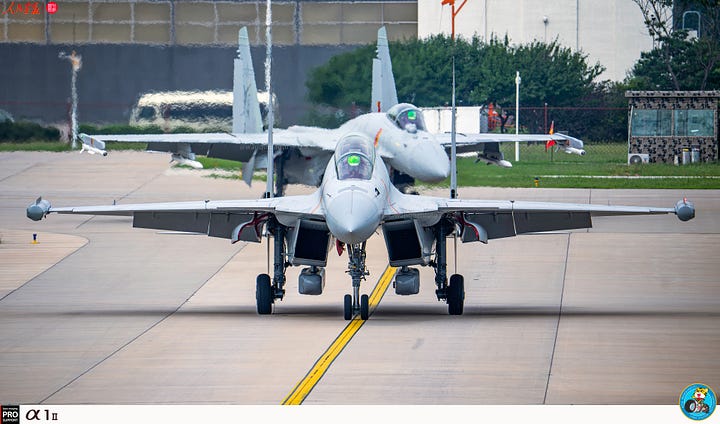

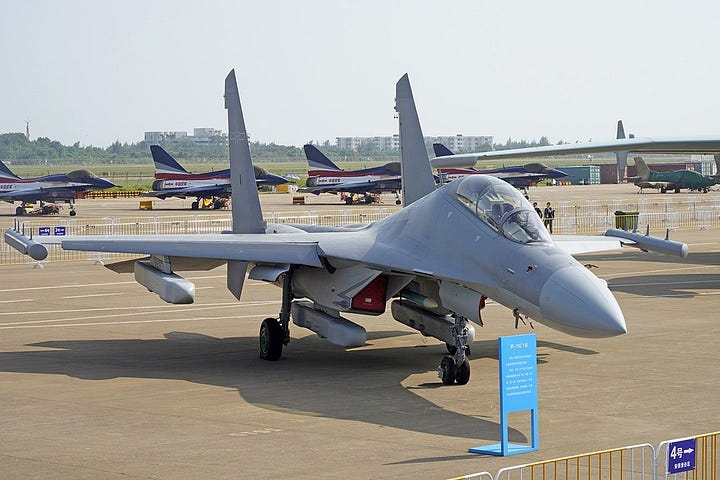
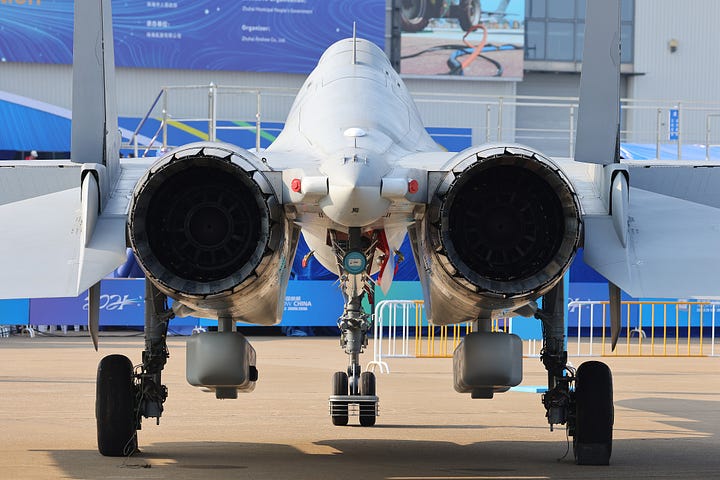
Images 3-4 show a PLAAF J-16D, the PLAAF's land-based counterpart to the J-15DT, for comparison.

